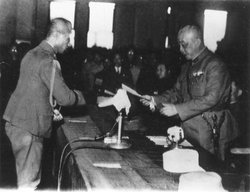Chen Yi (Kuomintang)
|
|
Chenyi.jpg
Chen Yi (陳儀 pinyin: Chén Yí; Wade-Giles: Ch'en I; 1883 - June 18, 1950) was the Chief Executive and Garrison Commander (警備總司令) of Taiwan after it was surrendered from Japan to Republic of China, which acts on behalf of the Allied Powers, in 1945. His infamous mishandling of the tension between Taiwanese locals and Mainlanders precipitated in the February 28 Incident, and he was dismissed later for disloyalty (though for reasons unrelated to his tenure in Taiwan).
| Contents |
Early life
Courtesy names Gongxia (公俠) and later Gongqia (公洽), sobriquet Tuisu (退素), Chen was born in Shaoxing, Zhejiang and went to study in a military academy in Japan in 1902 for seven years. He joined Guangfuhui while in Japan. He returned to Japan in 1917 to study in a military university for three years, then he resided in Shanghai.
He was the chairman senator (總參議) and governor of Zhejiang (since October 1925). Chen was also the leader of the 19th Route Army of the National Revolutionary Army (國民革命軍第十九路軍軍長). After 1927, he worked in the Military Affairs Department (軍政部), then as the chairman of Fujian in 1933, and Secretary-General of the Executive Yuan.
Chen and Formosa
In 1935, Chen was sent to Taiwan by Chiang Kai-shek to attend "Exposition to Commemorate the 40th Anniversary of the Beginning of Administration in Taiwan," an exposition which has remained unique and unrivaled to this day, and which served as a report on the achievements of Taiwan's modernization process under Japanese rule. During his stay in Taiwan, he praised the modern public facilities and the strong economic development in Taiwan under Japanese rule. Chen publicly expressed his admiration with jealousy about the advanced life quality Taiwanese people enjoyed compared with the Chinese mainlanders who suffered from prolonged war incurred destruction and lack of further modernization. After he went back to Fujian, he filed a report to Chiang Kai-shek about his visit. With his experience in Japan and Taiwan, Chen had became the first candidate as the Taiwan governor in Chiang's mind after Japan relinquished the sovereignty of Taiwan.
Under the authorization of Douglas MacArthur's General Order No. 1 [1] (http://www.taiwandocuments.org/surrender05.htm), Chen Yi was escorted by George Kerr to Taiwan for accepting Japan government's surrender as the Chinese delegate. On October 25 1945, joined by delegates from Allied Powers, Chen signed a surrender instrument with General Ando Rikichi, governor-general of Taiwan, in Taipei City Hall (current Zhongshan Hall). Chen Yi proclaimed that day to be the retrocession day of Taiwan which was regarded as legally controversial as Japan had not yet ceded Taiwan in any treaty until 1952.
Chen was later removed from the position of Taiwan governor general for his mishandling of the administration of Taiwan which resulted in the 228 Incident. In the early years of Chinese rule, rampant corruption in the new administration headed by Chen caused severe inflation, which in turn lead to widespread local discontent. Allegations of carpet bagging by new immigrants from the mainland and a breakdown in social and governmental services also served to increase tensions. As the Shanghai newspaper Wen Hui Pao remarked, Chen ran everything "from the hotel to the night-soil business." The Taiwanese felt like colonial stepchildren rather than long-lost sons of Han.
Anti-mainlander violence flared on February 28, 1947, prompted by an incident in which innocent civilians were injured and shot to death by ROC authorities. For several weeks after the February 28 Incident, the rebels held control of much of the main island of Taiwan. Under orders from Chiang Kai-shek, Chen deployed military troops from the mainland against the Taiwanese insurgents. By April, Chen had executed or jailed all the leading rebels he could identify and catch, and his troops had wantonly slaughtered (said a Taiwanese delegation in Nanjing) between 3,000 and 4,000 throughout the island.[2] (http://228.lomaji.com/news/040747b.html) Tens of thousands of Taiwanese civilians, including many of the social elite, died in the resulting massacres and purges which drew widespread international attention. Following protests by the United States Congress, Chiang dismissed Chen from his position as governor general to appease international pressure.
Following his dismissal from the post of Taiwan governor general, Chen was employed as a consultant. In June 1948, he took the position of provincial chairman of Zhejiang province. In November, he released over a hundred communists scheduled to be executed. In January 1949, his subordinate, Tang Enbo (湯恩伯), informed Chiang Kai-shek that Chen had advised him to rebel against the Kuomintang. Chiang immediately relieved Chen's chairmanship on the charge of collaboration with the Communists. On May 30, Chen Yi was transported to Taiwan to be imprisoned; he was later executed at Machangting (馬場町), Taipei, and was buried in Wuku, Taipei County.
Quotes from Chen
- "Mainland Chinese were advanced enough to enjoy the privileges of constitutional government, but because of long years of despotic Japanese rule, the Formosans were politically retarded and were not capable of carrying on self-government in an intelligent manner."(1947)[3] (http://www.jamestown.org/publications_details.php?volume_id=395&issue_id=3123&article_id=2368763)
- "It took the Japs [sic.] 51 years to dominate this island. I expect to take about five years to re-educate the people so they will be more happy with Chinese administration."(1947)[4] (http://228.lomaji.com/news/040747b.html)
- "I never forgot private enterprise. I always intended to re-establish it."(1947)[5] (http://www.time.com/time/archive/preview/0,10987,793650,00.html)

